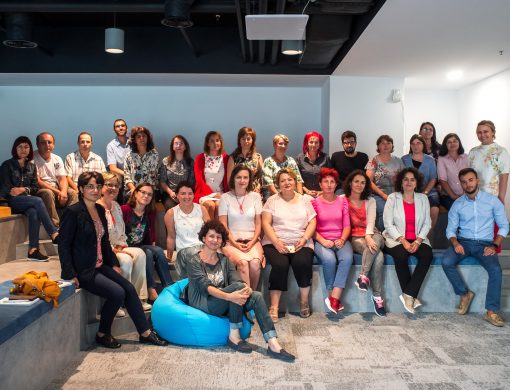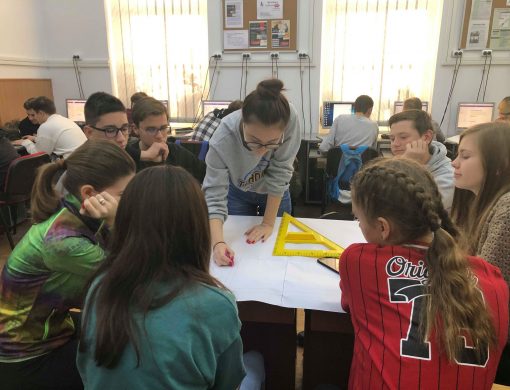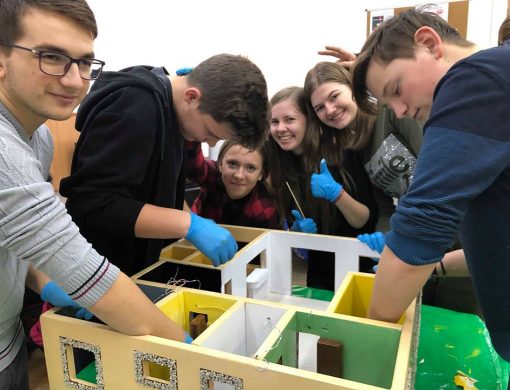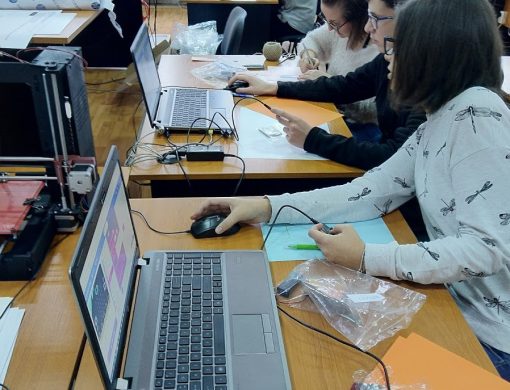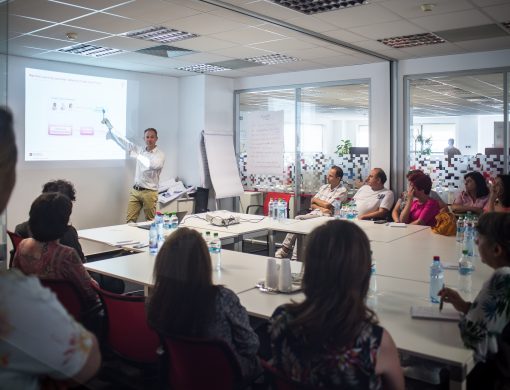Text published in RAF’s 2018 Annual Report
A goldfish has a nine-second attention span. At first glance this statistic may not seem to have anything to do with us, but this is almost the equivalent of our attention-span in the digital era of eight seconds.
Technology develops at exponential speed rather than gradually. Previous technological revolutions could be registered over a lifetime, while now we witness numerous leaps in the course of a single life. This pace of change is humankind’s greatest challenge: the speed at which we’re exposed to information and the speed at which we can retain this information. This speed also predicates the attention-spans of different generations; that of a generation which is exposed to an increased level of visual information compared to the preceding one, for example.
This was the idea behind initiating the partnership between the Romanian-American Foundation (RAF) and the Techsoup Association when the Foundation chose Techsoup as its development partner in the fields of technology and innovation. In 2016 they laid the groundwork for a program designed to completely change the paradigm for teaching computer science in schools. The Techsoup Association “was already working with kids who were good with computer science, helping them to excel”, says Suzana Dobre, who coordinates the RAF’s education programs. When you’re here to stay, as is the case of the Romanian-American Foundation, the projects you’re involved in take on meaning when they effect change. And change takes time. And a great deal of patience in order for it to happen. Even in tech, where things are moving at a dizzying pace.
The project was called Teaching the Future and had the best possible foundation: the great mutual trust between the financer and the grant-recipient in matters of ability, expertise and vision. Elena Coman (Techsoup) and Suzana Dobre (RAF) knew their plan was ambitious even as they began working together to change perceptions about the teaching of computer science. As Techsoup was already working with high-school students on interesting computer science projects, it occurred to Suzana that working together on a program aimed at teachers would have a bigger impact, as the benefit would be passed on to a greater number of students. With a “it’s worth trying” from Elena and a common will to transform the teaching of computer science, the Teaching the Future project became teacher-focused. It was in fact teachers who had the power to influence how young people perceived computer science and the way it was learned in the classroom. Still, the way in which the material was taught needed to change. The solution found was project-based learning, a more interactive way of presenting computer science to young people. What is project-based learning? “What is taught becomes secondary and is subsumed to the greater process, which is bigger than the student and teaches the student problem solving. Instead of going to school and learning Python, you go to school and learn how to make an application that helps organizations in your town raise funds faster, and at the same time you learn Python. It’s an incredibly efficient way of learning and very well adapted to a generation that needs to see the point of what it’s studying”, explains Elena.
The project then entered the test phase and became an accelerator lasting six to seven months. It taught teachers to apply project-based learning (called product development in IT) together with students, in the classroom. Techsoup put the teachers in contact with the IT industry and other stakeholders in the tech domain in order to inspire them to transform their computer science lessons into real-life experience. More than that, in those months the teachers saw the benefit of an educational model in which theory is included in a much broader way in the making of an IT product. At the same time, they discovered how to help their students develop their abilities, rather than just passing on information.
‘When you work in the classroom, the kids don’t just code. They have other plans, they know what they want to achieve. Every student in the team has a role: one learns coding, another learns marketing, and so on,’ says Elena. Practically, to meet their goals, to finish constructing something, the students learned to cooperate and to empathize with each other. They learned through doing, but in a fun and engaging way, with theory merged with practice. The theoretical aspect seemed to magically disappear, when in fact it had been better and more systematically integrated.
The accelerator was a success, but good practices need… practice. The teachers needed to practice what they’d learned during the accelerator, though they felt more comfortable doing this outside computer science lessons than within. During this time, Asociația Techsoup followed-up to keep the teachers connected to the happening world of IT and to inspire and implement new classroom models: they got involved in workshops, hackathons, meetings with people from IT and high-profile events. And they found that even if you create the context, change doesn’t always happen by itself.
At the end of what would be the first run of the accelerator, the partnership between Asociația Techsoup and the Romanian-American Foundation became an alliance. The initial trust was strengthened by the kind of patience that is indispensable for innovation, because innovation is, in fact, a well-structured process and not just an ‘aha’ moment. The first stage is conceptual – Teaching the Future was the idea. The accelerator was the second stage, that of research and development. The third stage of innovation involves proof of concept.
Suzana and Elena asked themselves: “Okay, what have we done? How can we take it further?”. Suzana: “We had some proof of concept in the first year, we knew the part involving the industry motivated everybody. But we didn’t know how to change how it was taught in schools.” Instead of being put off by an apparent lack of results, the two organizations learned their lessons and moved forward. If you want to innovate, in fact, you can’t stop. It’s a fluid process. You try, then see if what you’ve attempted has yielded results. If it hasn’t, you go back and see if you can do it better. But you don’t give up.
And they didn’t give up. Instead, they offered the teachers even more ways for them to feel ownership of the new ways of teaching, helped them to develop their teaching skills even further, so that they could empathize more with the students and connect emotionally with them. Elena realized that Techsoup excelled at microlearning – learning experiences for NGOs that could be encapsulated in an hour. “Could we do the same thing with the teachers too?” she wondered. And with this question the second phase of the project began, with a return to research and development. They then created a series of webinars about Scratch – a opensource programming language and an online community in which students could create their own stories and learn much more easily. They adapted it for beginners but in intensive modules in which teachers learned to manage projects that took place over many lessons. 89 teachers did classroom activities after these webinars and returned with feedback from the students.
Fast forward to the middle of 2018. Elena and Suzana are talking on Skype with researchers from Cambridge University who have heard of the Teaching the Future program. Cambridge had already created a methodology for project based learning for high-school students, in which, over 12-18 weeks, with the help of teaching materials such as gadgets called Micro:bit, the students learned to solve problems, supported by their teachers. ‘Interesting problems’, says Elena, ‘of inclusive design, which need to answer the question: how can we redesign a salt-cellar that takes into account that the world’s population is aging and there will be increasing numbers of people with arthritis who won’t be able to use it? They knew this was a big question that demanded an answer, and the activities introduced by the teacher helped them learn about population, the world, people, inclusivity, design and empathy, up until the point where they were producing products and presenting them.’
After an exchange of experience in which a group of Teaching the Future teachers travelled to the UK, the Cambridge researchers came to Romania in December to visit the ”National Gas School”, a technical school in Mediaș. They piloted the methodology there together: they chose a high-school class and divided it into a control group and a test group and measuring the test group before and after changing the way they were taught. They discovered that it worked: the students in the test group had greater faith in their ability to solve problems and were much more open to trying new things. They showed greater creativity and were more willing to solve problems by thinking outside the box. It seemed that the program had passed the proof of concept phase, but in reality more time is needed to see the long-term effects.
What’s next? ‘Looking ahead, we have developed the concept in three directions, each with a clearly defined set of expectations, from the effects it can have on teachers and students, with several variants of evaluation being explored, but not in terms of final results. Now, really, we’re going back to the proof of concept phase, and we’re going to look at three levels of the model: the accelerator, the webinars and the Cambridge DOT program. These are going to meet the Romanian educational system we’re going to see the effects of this, even at a small scale. Then we’ll see if the promising early results are repeated over the longer term. If they are, we’ll see what the opportunities are for increasing the scope and influence of the program.’, explains Suzana.
Though the Romanian-American Foundation and Asociația Techsoup estimate the proof of concept phase of the program will last three years, they have already begun to consider the next steps, which will make Teaching the Future an example of project base learning for both parties involved: always thinking of something bigger, beyond the present moment, learning from what they’re doing, going back to perfect it, test it, and to ascertain if the results justify the effort. Throughout this process, in which they’ve succeeded in transforming teachers into facilitators, reinterpreting their classroom role so that computer science becomes a creative enterprise, the greatest resource has been patience. In a world in which patience is quickly lost, it seems our attention has become steadily more selective rather than diminished.
Attention spans haven’t got shorter. They depend on our engagement with the task in front of us and the degree of attention we need to devote to concluding it successfully. In other words, our attention is purpose-driven in the era we live in. And engaging the attention of high-school students, who are digital natives, having been in contact with technology since childhood, requires making the things they learn meaningful. Now, with the Techsoup association, computer science classes are much more meaningful. Because they are an introductory course in how we can make the world we live in a better place, through small changes, lesson by lesson and hour by hour, and without being deskbound. It teaches how to ask ourselves the right questions, research, learn, apply and follow up.




